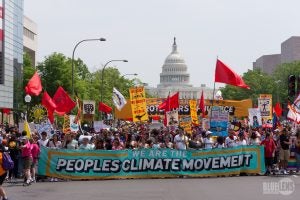5 opportunities for renewed American climate leadership on methane
 With Joe Biden winning the 2020 U.S. presidency, attention now shifts to how his administration will prioritize domestic and international climate action in the context of COVID-19 and its related economic repercussions.
With Joe Biden winning the 2020 U.S. presidency, attention now shifts to how his administration will prioritize domestic and international climate action in the context of COVID-19 and its related economic repercussions.
Among the most powerful elements of a reinvigorated American climate strategy is assertive action to reduce methane pollution. At least 25% of today’s global warming is caused by methane emissions from human activities, including production and use of fossil fuels, agriculture and municipal waste. One of the world’s largest sources of manmade methane pollution is the oil and gas industry.
Oil and gas methane emissions also present a particularly important climate opportunity, as it offers the most immediate and lowest cost option to reduce a potent greenhouse gas.
Early action by the Biden administration to cut U.S. methane emissions is a chance to make quick climate progress and establish international credibility. This holds true even if President-elect Biden takes steps to slow or stop new oil and gas production on federal lands because of how much oil and gas we produce.
EDF and other environmental groups, including National Resources Defense Council and World Resources Institute, outlined policy and diplomacy priorities for the new administration to consider. Methane is a critical one. Not only is it an important piece of a comprehensive climate strategy, it is one on which the United States can seize global momentum.
5 opportunities for renewed American climate leadership on methane Share on XHere are five key areas where renewed American climate leadership can make a difference on methane.
- Reengage in the Climate & Clean Air Coalition on Short Lived Climate Pollutants that was created by the United States, Canada, Mexico, Bangladesh, Ghana, and Sweden to reduce methane and other super-pollutants in 50 UN countries. An energized CCAC with strong U.S. support can push the potential of multilateral efforts, including the Oil and Gas Methane Partnership 2.0, in improving data quality and transparency as countries look to develop stronger mitigation measures.
- Take a leadership role in the Global Methane Alliance. Under the auspices of the UN Environment Program, the GMA brings together national governments, international organizations, non-governmental organizations, financing institutions, and oil and gas companies to help countries set and achieve ambitious methane reductions from fossil fuel sources. Active U.S. diplomatic leadership with a renewed climate mandate could turbocharge efforts to drive down global methane emissions by 2030.
- Put methane squarely on the agenda of the UN Climate Change Conference in Glasgow by co-leading a diplomatic effort with the U.K. (COP26 host) and other likeminded governments that have a significant stake in decarbonizing the economy. An ideal effort would include enlisting 10 or more of the largest fossil fuel producing and consuming countries and get them to sharply reduce methane emissions associated with oil, gas and coal development, use and retirement. Again, the power of a reengaged United States on climate that also prioritizes methane as a key part of its bilateral and multilateral relations can help drive others to reduce this menacing greenhouse gas.
- Encourage Europe to use its market position as the world’s largest gas importer to implement an industry performance standard that will incentivize use of cleaner gas consumed in Europe, and leverage the standard to encourage similar action by other major importers like China, Japan and South Korea. The new administration should stress that methane reductions will be a central part of U.S. trade and energy policy and that future gas exports to these markets will be judged on methane performance.
- Tackle methane pollution across North America. U.S. climate leadership abroad must begin with meaningful climate action at home. As the world’s largest oil and gas producer, the United States must make reinstating the EPA’s methane protections a first 100-day priority. Swift regulatory action is vital for the health of communities living near oil and gas development and for climate safety.
Second, the new administration should re-engage with Canada and Mexico to jumpstart 2016 efforts that brought all three countries together to tackle methane emissions (North America accounts for 17% of global oil and gas emissions). Canada and Mexico have already enacted strong national methane regulation, but much needs to be done to deliver on their promised reductions. Recent analysis shows Canada’s regulations, for example, are falling short. Increased continental collaboration can help all three countries do better.
Without question, the new administration must keep its eyes squarely focused on the economy. In this regard, making the case for swift action on oil and gas methane should be a relatively manageable political lift. For example, plugging methane leaks and capping abandoned wells is not only a quick and effective methane control tactic, it will require the skills that thousands of oil and gas workers already possess.
Prime Minister Justin Trudeau dedicated nearly $2.5 billion (CAD) of the Canada’s stimulus package to put oil and gas workers back to work cleaning up tens of thousands of leaky orphaned and abandoned wells. That approach can work in America, too.
With methane, the new administration can take a real bite out of U.S. climate emissions while creating or saving thousands of jobs. That would resonate not only with key domestic constituencies, but also with critical international partners who will be looking closely at the concrete steps the new administration will take in its first days, weeks and months.
For U.S. diplomatic advocacy abroad to be effective, it must be grounded in credible and successful domestic policies. Action on methane is a priority that can help quickly reestablish our climate credibility and begin a new chapter of international climate leadership.










